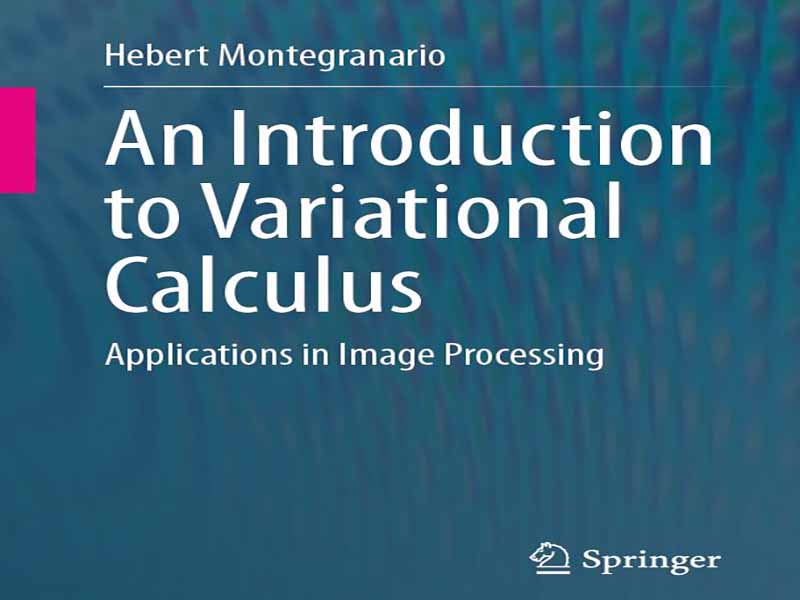- عنوان کتاب: An Introduction to Variational Calculus
- نویسنده: Hebert Montegranario
- حوزه: حساب متغیر
- سال انتشار: 2025
- تعداد صفحه: 154
- زبان اصلی: انگلیسی
- نوع فایل: pdf
- حجم فایل: 3.13 مگابایت
در این کتاب میخواهیم مقدمهای بر جنبههای کلاسیک و جدیدترین جنبههای حساب تغییری داشته باشیم. جنبه های کلاسیک به سنتی اشاره دارد که به زمان ایجاد این رشته با اویلر و لاگرانژ باز می گردد و تا زمان ما در ارتباط نزدیک با فیزیک، مکانیک پیوسته و سایر موضوعات بسیار کاربردی توسعه می یابد. جدیدترین جنبهها به این واقعیت اشاره دارد که بسیاری از موضوعات فناوری مدرن مانند بینایی کامپیوتر، رباتیک و بهویژه پردازش تصویر دیجیتال را میتوان بر حسب مسائل مختلف فرمولبندی کرد. این مسائل و راهحلهای جدید شیوه جدیدی از تفکر در مورد حساب متغیر را پیکربندی کردهاند که به شدت به الگوریتمها و برنامههای محاسباتی مرتبط است. با این حال، بیشتر کتابهایی که با کاربردهای حساب متغیر در بینایی کامپیوتری یا پردازش تصویر سروکار دارند، دانش گستردهای را از خواننده دریافت میکنند یا با نتایج تحقیقات مرزی اخیر سروکار دارند. در رویکرد ما، خواننده فقط به عناصر حساب دیفرانسیل و انتگرال، معادلات دیفرانسیل و اصول اولیه الگوریتم ها و برنامه نویسی نیاز دارد، اما نیازی به دانش قبلی از حساب متغیر ندارد. هدف این متن برقراری تعادل بین سه عنصر است: ریاضیات، کاربردها و اجرای محاسباتی، و ما میخواهیم این هدف در هفت فصلی که به آن تقسیم شده است منعکس شود. بنابراین، نمونه ها و الگوریتم های مربوط به پردازش تصویر در اسرع وقت در کتاب آمده است. در فصل 1 موضوع را معرفی می کنیم و انگیزه و توضیحات کلی می دهیم. فصل 2 شامل عناصر اساسی ریاضی است که در ادامه کتاب، ارجاعات هندسی به کار گرفته خواهد شد. از آنجایی که قرار است این یک کتاب مستقل باشد، فصل. 3 عناصر لازم را برای به دست آوردن یک رویکرد عملی به نظریه توزیع ها و تحلیل فوریه فراهم می کند. به عنوان بخشی از تئوری سیگنال، پردازش تصویر با استفاده از ابزارهای روش فوریه تکامل یافته است، بنابراین گنجاندن آن در متن مهم است. فصل 4 ایده های فوق را در مورد مفهوم مشتق متغیر و کاربرد آن در مسائل کلاسیک حساب تغییرات اعمال می کند. فصل 5 نشان می دهد که چگونه شناخته شده ترین مشکلات بینایی کامپیوتری در واقع مسائل معکوس هستند که می توانند با استفاده از نظم دهی متغیر حل شوند. فصل 6 و 7 به برخی از شناخته شده ترین کاربردها در پردازش تصویر می پردازد.
In this book we want to make an introduction to both the classic and the most recent aspects of variational calculus. The classical aspects refer to the tradition that goes back to the time of creation of this discipline with Euler and Lagrange and that develops until our time in close relationship with physics, continuum mechanics, and other highly applicable topics. The most recent facets refer to the fact that many topics of modern technology such as computer vision, robotics, and, in particular, digital image processing can be formulated in terms of variational problems. These new problems and solutions have configured a new way of thinking about variational calculus, strongly related to algorithms and computational applications. However, most books dealing with applications of variational calculus in com- puter vision or image processing assume extensive knowledge from the reader or deal with more recent frontier research results. In our approach, the reader only needs elements of Calculus, differential equations, and basic principles of algorithms and programming, but does not need previous knowledge of Variational Calculus. This text aims to balance three elements: mathematics, applications, and compu- tational implementation, and we want this intention to be reflected throughout the seven chapters into which it is divided. Therefore, examples and algorithms related to image processing appear in the book as early as possible. In Chap. 1 we introduce the topic and give a motivation and general description. Chapter 2 contains the basic mathematical elements that will be applied in the rest of the book, making geometric references. Since this is intended to be a self-contained book, Chap. 3 provides the necessary elements to obtain a practical approach to the theory of distributions and Fourier analysis. As part of signal theory, image processing has evolved using the tools of Fourier methods, so it is important to include it in the text. Chapter 4 applies the above ideas to the notion of variational derivative and its application to classical problems of variational calculus. Chapter 5 shows how the most well-known computer vision problems are actually inverse problems that can be solved using variational regularization. Chapters 6 and 7 deal with some of the most well-known applications in image processing,
این کتاب را میتوانید از لینک زیر بصورت رایگان دانلود کنید:
Download: An Introduction to Variational Calculus




































نظرات کاربران